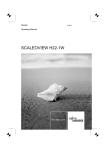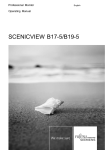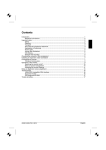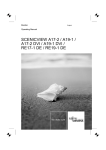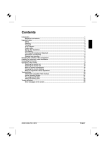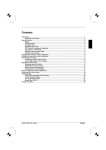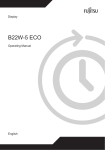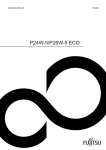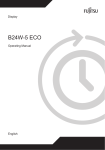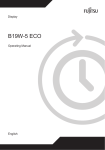Download Fujitsu B17-3 Computer Monitor User Manual
Transcript
Monitor English Operating Manual SCENICVIEW B17-3/B19-3/P19-3 Are there… ... any technical problems or other questions which you would like to be clarified? Please contact our help desk (see Warranty Booklet). The latest information on our products, tips, updates, etc., can be found on the internet under: http://www.fujitsu-siemens.com This manual was produced by Xerox Global Services Published by Fujitsu Siemens Computers GmbH Order No.: A26361-K1143-Z120-1-7619 Edition 3 AG 08/07 SCENICVIEW B17-3/B19-3/P19-3 LCD monitor Operating Manual august 2007 edition VESA, DDC and DPMS are registered trademarks of Video Electronics Standards Association. Copyright © Fujitsu Siemens Computers GmbH 2007 All rights, including rights of translation, reproduction by printing, copying or similar methods, in part or in whole, are reserved. Offenders will be liable for damages. All rights, including rights created by patent grant or registration of a utility model or design, are reserved. Delivery subject to availability. Right of technical modification reserved. No liability for content and printing error. Contents Introduction........................................................................................................................................... 1 Notational conventions ................................................................................................................. 2 Important notes..................................................................................................................................... 2 Safety notes.................................................................................................................................. 2 Power cable.................................................................................................................................. 4 Transport ...................................................................................................................................... 4 Cleaning ....................................................................................................................................... 4 CE marking................................................................................................................................... 4 FCC Class B Compliance Statement ........................................................................................... 5 Declaration of Conformity ............................................................................................................. 5 Energy Star Guidelines................................................................................................................. 6 Disposal and recycling ................................................................................................................. 6 Checking the contents of the consignment........................................................................................... 7 Installing an ergonomic video workstation............................................................................................ 8 Mounting and removing the monitor base ............................................................................................ 9 Folding out monitor base.............................................................................................................. 9 Removing monitor base ............................................................................................................. 11 Connecting the monitor .............................................................................................................. 12 Connecting cables to the monitor............................................................................................... 13 Connecting cables to the computer............................................................................................ 14 Operation of the monitor..................................................................................................................... 14 Adjusting height, rake and rotation............................................................................................. 14 Adjusting portrait format ............................................................................................................. 15 Switching the monitor on and off (B17-3 / B19-3)....................................................................... 15 Switching the monitor on and off (P19-3) ................................................................................... 16 Notes on power management .................................................................................................... 17 Changing the monitor settings.................................................................................................... 18 Notes on ergonomic colour adjustment .............................................................................................. 23 Troubleshooting.................................................................................................................................. 24 Notes regarding the DIN EN ISO 13406-2 standard .......................................................................... 26 Technical data .................................................................................................................................... 27 VESA-DDC-compatible VGA interface....................................................................................... 28 Preset operating modes ............................................................................................................. 28 Pin assignment D-SUB............................................................................................................... 29 Monitor port DVI-D...................................................................................................................... 29 A26361-K1143-Z120-1-7619, edition 3 Contents A26361-K1143-Z120-1-7619, edition 3 Introduction Your new LCD (Liquid Crystal Display) monitor SCENICVIEW B17-3/B19-3/P19-3 offers numerous features and functions, for example: ● ● ● ● ● ● TFT display (Thin Film Transistor; active matrix) minimal space requirements thanks to slim casing optimum ergonomic characteristics (totally distortion-free, excellent picture definition and colour purity right into the corners) high degree of brightness and good contrast high resolution (1280 x 1024) presentation of up to 16.7 million colours (in conjunction with an appropriate graphics card) automatic scanning of horizontal frequencies from 30 to 82 kHz and refresh rates (vertical frequencies) from 56 to 76 Hz (absolutely flicker-free) digital screen controller with microprocessor for storing 26 different display modes freely adjustable colour alignment for matching the screen colours to the colours of various input and output devices convenient operation via integrated OSD (On-Screen-display) menu VESA-DDC compatibility VESA-FPMPMI compatibility (Flat Panel Monitor Physical Mounting Interface) – Mounting device for swivel arm and wall bracket plug&play capability power management for reducing power consumption when the computer is not in use compliance with the recommendations in accordance with TCO’03 ● The monitor fulfils all GS (“Geprüfte Sicherheit”, Certified Security) requirements. ● ● ● ● ● ● ● ● ● This operating manual contains important information you require to start up and run your LCD monitor. A graphics card (screen controller) with VGA interface or a digital graphics card with DVI interface is required to control the SCENICVIEW B17-3/B19-3/P19-3 LCD monitor. The monitor processes the data supplied to it by the screen controller. The screen controller or the associated driver software is responsible for setting the modes (resolution and refresh rate). When putting the monitor into operation for the first time, the screen display should be optimally adapted to the screen controller used and adjusted in accordance with your needs (see the "Changing the monitor settings" section in the "Operation of the monitor" chapter). Target group You don't need to be an "expert" to perform the operations described here. However, please observe the safety information given in the operating instructions of the computer and in this manual. In the event of any problems occurring, please contact your sales outlet or our help desk. Additional information Details of how you set the resolution and refresh rate are provided in the documentation on your screen controller/the associated driver software. For ergonomic reasons we recommend a screen resolution of 1280 x 1024 pixels for the monitors SCENICVIEW B17-3, B19-3 and P19-3. Because of the technology used (active matrix) an LCD monitor provides a totally flicker-free picture even with a refresh rate of 60 Hz. A26361-K1143-Z120-1-7619, edition 3 1 SCENICVIEW B17-3/B19-3/P19-3 Notational conventions The meanings of the symbols and fonts used in this manual are as follows: ! Pay particular attention to text marked with this symbol. Failure to observe this warning endangers your life, destroys the device, or may lead to loss of data. i Supplementary information, remarks, and tips follow this symbol. ► Text which follows this symbol describes activities that must be performed in the order shown. "Quotation marks" indicate names of chapters or terms. This font indicates filenames and menu items. This font indicates screen outputs. Important notes ! In this chapter you will find information regarding safety which is essential to take note of with your monitor. Safety notes This device complies with the relevant safety regulations for data processing equipment, including electronic office machines for use in an office environment. If you have any questions, contact your sales outlet or our help desk. ● The display surface of the LCD monitor is sensitive to pressure and scratches. You should therefore be careful with the display surface so as to avoid lasting damage (scratches). ● If the device is brought into the installation site from a cold environment, condensation can form. Before operating the device, wait until it is absolutely dry and has reached approximately the same temperature as the installation site. ● During installing and operating the device, please observe the instructions on environmental conditions in the "Technical data" chapter as well as the instructions in the "Installing an ergonomic video workstation" chapter. 2 A26361-K1143-Z120-1-7619, edition 3 SCENICVIEW B17-3/B19-3/P19-3 ● To ensure sufficient ventilation, the intake and exhaust air openings of the monitor must never be blocked. ● The monitor automatically sets itself to a mains voltage in the range of 100 V to 240 V. Ensure that the local mains voltage lies within these limits. ● Ensure that the power socket on the device or the grounded mains outlet is freely accessible. ● The ON/OFF switch does not disconnect the device from the mains voltage. To completely disconnect the mains voltage, remove the power plug from the socket. ● The monitor is equipped with a power cable that complies with safety standards. ● Lay all cables so that nobody can stand on them or trip over them. When attaching the device, observe the relevant notes in the "Connecting the monitor" chapter. ● No data transfer cables should be connected or disconnected during a thunderstorm. ● Make sure that no objects (e.g. jewellery chains, paper clips, etc.) or liquids get inside the device (danger of electric shock, short circuit). ● The device is not waterproof! Never immerse the device in water and protect it from spray water (rain, sea water). ● In emergencies (e.g. damaged casing, elements or cables, penetration of liquids or foreign matter), switch off the unit, disconnect the power plug and contact your sales outlet or our help desk. ● The monitor must be disposed of in accordance with the local regulations for disposal of special waste. The screen background lighting contains mercury. You must observe the applicable handling and disposal safety regulations for fluorescent tubes. ● Only qualified technicians should repair the device. Unauthorised opening and incorrect repair may greatly endanger the user (electric shock, fire risk). ● You may set only those resolutions and refresh rates specified in the "Technical data" chapter. Otherwise you may damage your monitor. If you are in any doubt, contact your sales outlet or our help desk. ● Use a screen saver with moving images and activate the power management for your monitor to prevent still images from "burning in". ● If you operate the monitor with the swivel arm or wall bracket, it may not be turned by 180°. ● The SCENICVIEW B17-3/B19-3/P19-3 monitor may only be operated in landscape mode (0°) and portrait mode (90°). The control buttons are located at the bottom of the monitor in landscape mode (0°) and at the left-hand side of the monitor in portrait mode (90°). ● Store this manual close to the device. If you pass the device on to third parties, you should pass this manual on with it. A26361-K1143-Z120-1-7619, edition 3 3 SCENICVIEW B17-3/B19-3/P19-3 Power cable To guarantee safe operation, use the cable supplied. Use the following guidelines if it is necessary to replace the original cable set. ● The female/male receptacles of the cord set must meet IEC60320/CEE-22 requirements. ● The cable has to be HAR-certified or VDE-certified. The mark HAR or VDE will appear on the outer sheath. ● For devices which are mounted on a desk or table, type SVT or SJT cable sets may be used. For devices which sit on the floor, only SJT type cable sets may be used. ● The cable set must be selected according to the rated current for your device. ● If necessary, replace the original power cable with a regular grounded 3-core mains lead. Transport ● Transport the monitor with care and only in its original packaging or another corresponding packaging fit to protect it against knocks and jolts. ● Never drop the LCD monitor (danger of glass breakage). Cleaning ● Always pull out the power plug before you clean the monitor. ● Do not clean any interior parts yourself, leave this job to a service technician. ● Do not use any cleaning agents that contain abrasives or may corrode plastic. ● Ensure that no liquid will run into the system. ● Ensure that the ventilation areas of the monitor are free. ● The display surface of the LCD monitor is sensitive to pressure and scratches. Clean it only using a soft, slightly moistened cloth. Wipe the monitor casing with a dry cloth. If the monitor is particularly dirty, use a cloth which has been moistened in mild domestic detergent and then carefully wrung out. CE marking The shipped version of this device complies with the requirements of the following EC Directives: 2004/108/EC "Electromagnetic Compatibility" and 2006/95/EC "Low Voltage Directive". 4 A26361-K1143-Z120-1-7619, edition 3 SCENICVIEW B17-3/B19-3/P19-3 FCC Class B Compliance Statement The following statement applies to the products covered in this manual, unless otherwise specified herein. The statement for other products will appear in the accompanying documentation. NOTE: This equipment has been tested and found to comply with the limits for a "Class B" digital device, pursuant to Part 15 of the FCC rules and meets all requirements of the Canadian InterferenceCausing Equipment Standard ICES-003 for digital apparatus. These limits are designed to provide reasonable protection against harmful interference in a residential installation. This equipment generates, uses and can radiate radio frequency energy and, if not installed and used in strict accordance with the instructions, may cause harmful interference to radio communications. However, there is no guarantee that interference will not occur in a particular installation. If this equipment does cause harmful interference to radio or television reception, which can be determined by turning the equipment off and on, the user is encouraged to try to correct the interference by one or more of the following measures: ● ● ● ● Reorient or relocate the receiving antenna. Increase the separation between equipment and the receiver. Connect the equipment into an outlet on a circuit different from that to which the receiver is connected. Consult the dealer or an experienced radio/TV technician for help. Fujitsu Siemens Computers GmbH is not responsible for any radio or television interference caused by unauthorised modifications of this equipment or the substitution or attachment of connecting cables and equipment other than those specified by Fujitsu Siemens Computers GmbH. The correction of interferences caused by such unauthorised modification, substitution or attachment will be the responsibility of the user. The use of shielded I/O cables is required when connecting this equipment to any and all optional peripheral or host devices. Failure to do so may violate FCC and ICES rules. Declaration of Conformity This device complies with Part 15 of the FCC Rules. Operation is subject to the following two conditions: (1) this device may not cause harmful interference, and (2) this device must accept any interference received, including interference that may cause undesired operation. Product name: Colour LCD Monitor Trade name: Fujitsu Siemens Computers Inc. Model number(s): SCENICVIEW B17-3/B19-3/P19-3 Name of responsible party: Fujitsu Siemens Computers Inc. 1250E. Arques Avenue Sunnyvale, CA 94085 U.S.A. Contact person: Schroettle-Henning, Bernd Phone No.: (408) 834-0306 Fax No.: (408) 746-8299 We, Fujitsu Siemens Computers Inc., hereby declare that the equipment bearing the trade name and model number specified above was tested confirming to the applicable FCC Rules under the most accurate measurement standards possible, and that all the necessary steps have been taken and are in force to assure that production units of the same equipment will continue to comply with the Commissions requirements. A26361-K1143-Z120-1-7619, edition 3 5 SCENICVIEW B17-3/B19-3/P19-3 Energy Star Guidelines The Fujitsu Siemens LCD monitor SCENICVIEW B17-3/B19-3/P19-3 is designed to conserve electricity by dropping to less than 1 W when it goes into standby, suspend and OFF mode. With this new power management the LCD monitor SCENICVIEW B17-3/B19-3/P19-3 qualifies for the U.S. Environmental Protection Agency's (EPA) Energy Star Computers award. The EPA estimates that computer equipment uses 5 % percent of all business electricity and that this is growing rapidly. If all desktop computers and peripherals enter a low-power mode when not in use, the overall savings in electricity could amount to $ 2 thousand million annually. These savings could also prevent the emission of 20 million tons of carbon dioxide into the atmosphere - the equivalent of 5 million automobiles. As an Energy Star Partner, Fujitsu Siemens Computers GmbH has determined that this product meets the Energy Star guidelines for energy efficiency. Disposal and recycling This device has been manufactured to the highest possible degree from materials which can be recycled or disposed of in a manner that is not environmentally damaging. The device may be taken back after use to be recycled, provided that it is returned in a condition that is the result of normal use. Any components not reclaimed will be disposed of in an environmentally acceptable manner. If you have any questions on disposal, please contact your local office, our help desk, or: Germany Belgium Switzerland Fujitsu Siemens Computers GmbH Remarketing und Recycling D-33106 Paderborn Tel.: +49 5251 / 81 80 10 Fax: +49 5251 / 81 80 15 RECUPEL Boulevard Reyers, 80 B-1030 Brussels Tel.: +32 2 / 706 86 16 Fax: +32 2 / 706 86 13 E-Mail: [email protected] SWICO Schweizerischer Wirtschaftsverband der Informations-, Kommunikations- und Organisationstechnik http://www.fujitsu-siemens.de/wvm http://www.recupel.be A list of the SWICO Acceptance places can be found at: Asia USA Taiwan: Environmental Protection Administration Executive Yuan R.O.C. Fujitsu Siemens Computers Inc. 1250E. Arques Avenue Sunnyvale, CA 94085 U.S.A. Contact: Schroettle-Henning, Bernd Phone No.: (408) 834-0306 Fax No.: (408) 746-8299 http://www.swico.ch http://recycle.epa.gov.tw/ You can find more information on the Internet at www.fujitsu-siemens.com/recycling. 6 A26361-K1143-Z120-1-7619, edition 3 SCENICVIEW B17-3/B19-3/P19-3 Checking the contents of the consignment The display surface of the LCD monitor is sensitive to pressure and scratches. Always hold the device by the casing! ! ► Unpack all the individual parts. ► Check the delivery for damage incurred during transportation. ► Check whether the delivery agrees with the details in the delivery note. The complete LCD monitor package includes: – – – – – – – – one monitor one data cable (D-SUB) one data cable (DVI-D) one audio cable one power cable one CD with software and documentation one Warranty Booklet one "Getting Started" manual Should you discover that the delivery does not correspond to the delivery note, notify your local sales outlet immediately. i We recommend that you keep the original packaging material. Keep it for future transportation. A26361-K1143-Z120-1-7619, edition 3 7 SCENICVIEW B17-3/B19-3/P19-3 Installing an ergonomic video workstation 2 1 1 1= Windows Avoid direct and reflected glare. Avoid glare from electric lighting. 1= 2= Edge of desk Permissible reaching sector Position the keyboard where it is easiest to reach. 1 0° 65° 30° 60° 30° 65° 2 1= 2= Bearing surface for palms Example layout of monitor, keyboard and copy-holder of hands Reaching area for frequently used equipment Position the monitor for optimum viewing. The viewing distance to the monitor should be approximately 50 cm. i 1= 2= 2 Preferred viewing distance Permissible viewing distance Position the monitor for optimum viewing. The viewing distance to the monitor should be approximately 50 cm. Keep ventilated areas clear. Depending on the situation, the use of a swivel arm or wall bracket (VESA FPMPMI), are available from specialised dealers, may be advisable. For this purpose the monitor base must be removed beforehand as described in the "Mounting and removing the monitor base" chapter. 8 A26361-K1143-Z120-1-7619, edition 3 SCENICVIEW B17-3/B19-3/P19-3 Mounting and removing the monitor base ! The display surface is susceptible to scratching! Therefore, lay the monitor on a soft surface when mounting or removing the monitor base. Folding out monitor base When delivered the lower part of the monitor base is folded up and secured to the monitor by a collar. ! The monitor base springs up about 5 cm when the collar is released. ► Lay the monitor on its face on a soft surface (A). ► First release one of the collar fasteners (1). ► Release carefully the second collar fastener (2). The monitor base can now be folded out. A26361-K1143-Z120-1-7619, edition 3 9 SCENICVIEW B17-3/B19-3/P19-3 ► 10 Proceed according to the four steps in the illustrations to fold out the monitor base. A26361-K1143-Z120-1-7619, edition 3 SCENICVIEW B17-3/B19-3/P19-3 Removing monitor base Before you can use a swivel arm or a wall bracket, you must remove the monitor base: ! The display surface is susceptible to scratching! ► Switch off the monitor and pull the power plug out of the power socket. ► Lay the monitor on its face on a soft surface. ► Remove the cover and disconnect all cables. ► Remove the four screws on the rear of the monitor. You can now mount a swivel arm or a wall bracket as per VESA FPMPMI with 100 mm hole spacing. For instructions on how to mount the swivel arm or wall bracket, please see the documentation for the swivel arm or wall bracket. ! If you operate the monitor with the swivel arm or wall bracket, it may not be turned by 180°. A26361-K1143-Z120-1-7619, edition 3 11 SCENICVIEW B17-3/B19-3/P19-3 Connecting the monitor ! Please take note of the safety information in the "Important notes" chapter. CE conformance and optimum picture quality are guaranteed only if you use the data cables supplied. Do not cover the ventilation openings of the monitor. The computer power plug must be pulled out! ► 12 Be sure that the monitor and the computer are switched off. A26361-K1143-Z120-1-7619, edition 3 SCENICVIEW B17-3/B19-3/P19-3 Connecting cables to the monitor The monitor ports are protected by a cover. ► Remove the cover. 1 7 7 4 6 1= 2= 3= 4= 5= 6= 7= 2 3 5 Power connector DVI-D connection socket (DIGITAL) D-SUB connection socket (ANALOG) Security slot for "Kensington Lock" AUDIO-IN connector Cover position Holes for fixing swivel arm or wall bracket The data cables supplied have two 15-pin D-SUB connectors / two 24-pin DVI connectors for connection to the monitor and to the computer. ► Select the suitable data cable for your computer. Digital graphics card with DVI interface: DVI connector Graphics card with VGA interface: D-SUB connector Information on the computer connections and interfaces is contained in the operating manual for your computer. ► Connect one of the connectors of the data cable to the D-SUB connector (3) or the DVI-D connector (2) on the monitor and secure the plug-in connection by tightening the safety screws. i The monitor automatically detects the input when only one signal source is connected. ► Insert one plug of the audio line in the AUDIO IN (5) socket on the monitor and make sure it is properly engaged. ► Plug the power cable supplied into the power connector (1) of the monitor. ► Mount the cover over the connections. i A lock (Kensington Lock) can be mounted in the security slot (4) to protect the monitor from theft. A Kensington Lock is not included in the consignment of the monitor. A26361-K1143-Z120-1-7619, edition 3 13 SCENICVIEW B17-3/B19-3/P19-3 Connecting cables to the computer Information on the computer connections and interfaces is contained in the operating manual for your computer. i If your computer has two monitor ports ("onboard" screen controller and separate graphics card), the monitor port for the separate graphics card is usually active. ► Connect the data cable to the (active) monitor port on the computer and secure the plug-in connection by tightening the safety screws. ► Insert the other plug of the audio line in the audio output of the computer. ► Plug the connector of the mains cable provided into the monitor outlet of the computer or into a properly earthed outlet and ensure a safe connection. ► Plug the power connector of the computer into a properly grounded mains outlet. i When you start working with your monitor for the first time you should install the appropriate graphics drivers for your application software. Details of how to do this are provided in the documentation on your screen controller/the associated driver software. Operation of the monitor The monitor offers the following possibilities that enable it to be optimally adjusted for the respective user and the respective situation. Adjusting height, rake and rotation The height of the monitor can be adjusted by approximately 120 mm. ► Grasp the monitor with both hands on the right and left edge of the casing and move it up or down. The rake of the monitor can be adjusted by -2° (forward) and +35° (back) from its vertical position. ► Grasp the monitor with both hands on the right and left edge of the casing and adjust it to the desired rake. The monitor can be turned horizontally by approximately 90° from its central position. ► 14 Grasp the monitor with both hands on the right and left edge of the casing and turn it to the desired position. A26361-K1143-Z120-1-7619, edition 3 SCENICVIEW B17-3/B19-3/P19-3 Adjusting portrait format The monitor can be turned from the "wide format" (landscape mode) into the "high format" position (portrait mode). ► Grasp the monitor with both hands on the right and left edge of the casing, move it into the highest position and turn it clockwise until it is in the portrait position. i ► You must use corresponding software (pivot software) so that the screen display is also shown in the portrait mode. This software is included in the delivery (CD-ROM) and must be installed on your computer. In the OSD menu you have the option of switching the OSD manually from landscape mode into portrait mode (see section "Monitor settings using the OSD menu"). To reset the monitor to the landscape mode, the monitor must be turned counter-clockwise. The OSD display can be reset again in the OSD menu. Switching the monitor on and off (B17-3 / B19-3) The ON/OFF switch at the front is used for switching the monitor on and off. 3 2 1= 2= 3= 1 i 1 Buttons for the OSD menu (On-Screen-display) ON/OFF switch Power indicator 3 2 The buttons are to be pressed from the bottom upwards. A26361-K1143-Z120-1-7619, edition 3 15 SCENICVIEW B17-3/B19-3/P19-3 Switching the monitor on and off (P19-3) The main switch on the underside and the On/Off switch on the front of the monitor are used to switch it on and off. ► Switch on the monitor via the main switch (4) on the underside. 43 2 1= 2= 3= 4= 1 1 Buttons for the OSD menu (on-screen display) On/Off switch Mains power indicator Main switch 3 2 The mains power indicator (3) lights up blue when the monitor and the computer are switched on. The mains power indicator lights up orange when the monitor is not receiving a video signal or when it is in energy saving mode. The mains power indicator goes out when the monitor is switched off. When you switch the computer system on, you must proceed in the following order: ► First switch on the LCD monitor with the ON/OFF switch (2). ► Then switch on the computer. i 16 If your computer has a power management function (energy-saving mode), you should read the "Notes on power management" section in this chapter. A26361-K1143-Z120-1-7619, edition 3 SCENICVIEW B17-3/B19-3/P19-3 Notes on power management If your computer is equipped with power management, the monitor can support this function fully. Here the monitor does not distinguish between the individual energy-saving modes of the computer (standby mode, suspend mode and OFF mode), as it is capable of immediately switching into the mode with the highest energy-saving effect. Stage ON Power-Saving Mode Power indicator lights up blue lights up orange Function the monitor is working normally the screen is dark Power consumption Normal < 37 W typical reduced to < 1 W If your computer detects inactivity (no input) it sends an appropriate signal to the monitor to reduce the power consumption (energy-saving mode). The power indicator of the monitor changes colour to indicate the status change. Once an input is made at the computer the screen contents are redrawn and full power is restored. For detailed information on how energy-saving mode operates refer to the operating manual or technical manual of the computer. i When the monitor is switched to the energy-saving mode by the power management system a power consumption of up to 1 W is maintained to feed the circuit for redrawing the screen contents. In order to stop the monitor from using any power at all, switch it off at the main switch on the underside (P19-3). A26361-K1143-Z120-1-7619, edition 3 17 SCENICVIEW B17-3/B19-3/P19-3 Changing the monitor settings When putting the monitor into operation for the first time, the screen display should be optimally adapted to the screen controller used and adjusted in accordance with your needs. Choosing basic monitor settings using the supplied software If one of the operating systems Windows 95/98, Windows NT, Windows Me, Windows 2000, Windows XP or OS/2 (with Windows emulation installed) is used, the basic monitor settings can be set with the CD supplied. ► Insert the supplied CD into the CD-ROM drive. ► Open the Readme file on the CD and follow the instructions in the file. Your monitor should now already be properly adjusted. If none of the above operating systems is used or minor corrections are to be made to the screen display, then change the monitor settings with the OSD menu. Changing the monitor settings with the buttons of the control panel 1= Buttons for the OSD menu (On-Screen-display) 2= 3= ON/OFF switch Power indicator Use the buttons of the control panel to make the following monitor settings directly while the OSD menu is switched off. Performing auto-adjustment of the monitor ► Press the AUTO button for approx. 1 second while the OSD menu is switched off. The Auto Processing message is displayed. Picture quality and position are set to optimum values for your system. Selecting input signal (D-SUB/DVI-D) ► Press the INPUT button for calling the Input select setting window. ► Press the 6 or 5 button to select the desired input (analogue D-SUB or digital DVI-D). This setting window can also be called, when the OSD menu is locked. Activating/deactivating muting ► Press the button to switch the sound off and on again. A message is displayed that the action has been performed. 18 A26361-K1143-Z120-1-7619, edition 3 SCENICVIEW B17-3/B19-3/P19-3 Locking the OSD menu The OSD menu can be locked to prevent accidental or unauthorised changes to the monitor settings. ► Press and hold the SELECT/MENU button for a few seconds while you switch on the monitor with the ON/OFF switch. A message is displayed that the action has been performed. Please proceed in the same manner to release the locked OSD menu again. Locking the ON/OFF button The ON/OFF switch can be locked to prevent accidental or unauthorised changes to the monitor settings. Press and hold both buttons 6 and 5 simultaneously for a few seconds. ► A message is displayed that the action has been performed. Please proceed in the same manner to release the locked ON/OFF switch again. Monitor settings using the OSD menu With the buttons on the control panel, call up and use the integrated OSD (On-Screen display) menu. i The OSD menu is available in different languages. The English menu names are used in the following description (default setting). With the OSD function Language in the OSD Setup you can select another language. To set the OSD menu, perform the following steps: ► Press the SELECT/MENU button to activate the OSD menu. The main menu appears on the screen (on the left-hand side) with icons for the setting functions. The first symbol (Brightness/Contrast) is highlighted. In the right-hand part of the display the associated functions are shown. A26361-K1143-Z120-1-7619, edition 3 ► If necessary, press the 6 or 5 button to mark another icon (e.g. Image adjust). ► Press the SELECT/MENU button to select the highlighted icon. 19 SCENICVIEW B17-3/B19-3/P19-3 The corresponding setting window (here: Image Adjust) is displayed (on the right-hand side). The first function (H-Position) is highlighted. ► If necessary, press the 6 or 5 button to mark another function. ► Press the SELECT/MENU button to select the highlighted function. ► Press the 6 or 5 button to adjust the value for the selected function. ► Press the EXIT/AUTO button to exit the function. ► If necessary, press the button 6 or 5 to mark another function or press the EXIT/AUTO button to return to the main menu. All changes are stored automatically. If you want to change other settings, select the corresponding function from the OSD main menu. All possible adjustments of the main menu are described in the following. i The OSD menu for analogue monitor operation is described in the following. During digital operation some functions are not available, as they are not required due to the digital transmission technology used. Adjusting the brightness and contrast Calling the Brightness / Contrast setting window Brightness Contrast Setting the contrast of the display With this function you modify the contrast of bright colour tones. Black Level Setting the brightness of the display With this function you modify the contrast of dark colour tones. Auto Level Setting the brightness of the display With this function you can automatically set the contrast. Press the SELECT/MENU button to activate the function. i 20 Setting the brightness of the display With this function you change the brightness of the background lighting. If the contrast is set too high, bright surfaces can no longer be distinguished from very bright surfaces. If the contrast is set too low, the maximum brightness will not be achieved. A26361-K1143-Z120-1-7619, edition 3 SCENICVIEW B17-3/B19-3/P19-3 Adjusting size and position Calling the Image adjust setting window H-Position Adjusting the horizontal position With this function you move the picture to the left or to the right. V-Position Adjusting the vertical position With this function you move the picture up or down. Clock Setting synchronisation With this function you adjust the picture width to eliminate vertical picture disturbances. Phase Eliminating picture interference With this function you fine-tune your monitor to eliminate picture interference. Adjusting the volume Calling the Audio setting window Volume Mute Setting the volume for playback with the integrated loudspeakers Switching the loudspeakers off or on Setting colour temperature and colours Calling the Colour setting window Selecting the colour temperature The "warmth" of the screen colours is set using the colour temperature. The colour temperature is measured in K (= Kelvin). You can select from sRGB, 6500 K, 9300 K, Native and Custom Colour. sRGB = setting colour display according to the sRGB standard Native = Original colour of the LCD display Custom Colour = User-defined colours In the user-defined setting you can change the colour ratios of the basic colours (red, green, blue) as required. A26361-K1143-Z120-1-7619, edition 3 21 SCENICVIEW B17-3/B19-3/P19-3 Setting display of the OSD menu Calling the OSD Setup setting window Language Setting language for the OSD menu With this function you choose between English (default setting), French, German, Italian and Spanish as the language for the OSD menu. OSD H-Position Setting the horizontal position of the OSD menu With this function you move the OSD menu to the left or to the right. OSD V-Position Setting the vertical position of the OSD menu With this function you move the OSD menu up or down. OSD Timeout Setting the display duration of the OSD menu With this function you select a value from 10 to 120 seconds. If the set time expires without a setting being made, the OSD menu is automatically faded out. OSD Rotation Setting the display format of the OSD menu With this function you switch the OSD menu from portrait mode to landscape mode and vice versa. Off On = The OSD menu is displayed in portrait mode. = The OSD menu is displayed in landscape mode. Setting functions in the "Advanced" menu Calling the Advanced setting window Input select DDC-CI Selecting input signal With this function you switch the monitor from the analogue to the digital mode and vice versa, when two signal sources are connected. The condition is that the graphic card used supports this function. Activate/deactivate DDC-CI function On = the DDC-CI function is activated (default setting) Off = the DDC-CI function is deactivated Resolution Notifier Displaying monitor data The optimum resolution for this monitor is 1280 x 1024 pixels. With the function activated (On), a message appears on the screen after approx. 30 seconds if a different resolution is set. Change the resolution to 1280 x 1024 to achieve optimum picture quality. With the function deactivated (Off), no message appears. Factory Recall Activating the factory settings With this function all settings are reset to the factory settings without prompting for confirmation. Press the SELECT/MENU button to activate the function. The Auto Processing message is displayed. 22 A26361-K1143-Z120-1-7619, edition 3 SCENICVIEW B17-3/B19-3/P19-3 Displaying information Calling the Information setting window With this function the model designation, serial number, resolution, H/V frequency, input signal and polarity of the synchronisation signal are displayed. Notes on ergonomic colour adjustment If you select colours for the display in your application programmes, take note of the information below. The primary colours blue and red on a dark background do not produce the minimum required contrast of 3:1 and are therefore not suitable for continuous text and data entry. When using several colours for characters and background and giving the primary colours full modulation, you can obtain very suitable colour combinations (see the following table): Background Characters black black + - white purple blue cyan green yellow red + + - + + + - + + - - - + - - - - - + - + - - - - - - white + purple + + blue - + - cyan + - - + green + - - + - yellow + - + + - - red - + - - - - + + Colour combination very suitable Colour combination not suitable because colour locations are too close together, thin characters are not identifiable or rigorous focusing is demanded of the human eye. A26361-K1143-Z120-1-7619, edition 3 23 SCENICVIEW B17-3/B19-3/P19-3 Troubleshooting Should an error occur, first check the following points. If the distortion is still not eliminated, the monitor should, if possible, be checked on another computer. If you are unable to solve the problem, please inform our help desk. Having this problem? No screen display (power indicator does not light) Check the following points: ► Check whether the main switch on the underside of the monitor is switched on (P19-3). ► Check whether the power cable on the monitor is connected correctly. ► Check whether the computer is switched on. No screen display (power indicator lights) ► ► ► ► Message: No Signal ► ► Check whether the computer is switched on. Check whether the data cable for the monitor is correctly attached to the monitor port on the computer. Press any key on the computer keyboard - the computer may be in energy saving mode. Alter the brightness and/or contrast until you get a picture. Check whether the data cable for the monitor is correctly attached to the monitor port on the computer. Check whether the computer is switched on. Message: Frequency out of range: ## kHz / ## Hz The input signal (horizontal frequency and refresh rate) at the displayed input does not correspond to the technical monitor data. Please change the display mode to 1280 x 1024 with 60 Hz ► ► Picture position not correct Picture is shaking The monitor recognises an undefined mode (see the "Technical data" chapter). ► Press the EXIT/AUTO button to perform the autoadjustment of the screen. ► Check whether the data cable for the monitor is correctly attached to the monitor port on the computer. Press the EXIT/AUTO button to perform the autoadjustment of the screen. ► 24 Adjust the video frequency range using the computer software (see documentation for your computer or your graphics card). Adjust a different screen resolution using the computer software (see documentation for your computer or your screen controller). A26361-K1143-Z120-1-7619, edition 3 SCENICVIEW B17-3/B19-3/P19-3 Having this problem? Picture is wrongly adjusted Picture disturbances (vertical lines) Check the following points: ► Press the SELECT/MENU button to activate the function Factory Recall. The Auto Processing message is displayed. ► Press the EXIT/AUTO button to perform the autoadjustment of the screen. Picture disturbances (horizontal lines, picture noise) ► The screen becomes darker The background lighting has a limited lifetime. If your monitor display should become too dark, the background lighting will have to be exchanged. ► Please contact our help desk. A26361-K1143-Z120-1-7619, edition 3 Press the EXIT/AUTO button to perform the autoadjustment of the screen. 25 SCENICVIEW B17-3/B19-3/P19-3 Notes regarding the DIN EN ISO 13406-2 standard Permanently unlit or lit pixels The standard of production techniques today cannot guarantee an absolutely fault-free screen display. A few isolated constant lit or unlit pixels (picture elements) may be present. The maximum permitted number of pixels faults is stipulated in the stringent international standard ISO 13406-2 (Class II). Examples: A 17" or 19" flat-screen monitor with a resolution of 1280 x 1024 has 1280 x 1024 = 1310720 pixels. Each pixel consists of three subpixels (red, green and blue), so there are almost 4 million subpixels in total. In accordance with ISO 13406-2 (Class II), a maximum of 6 pixels and 7 subpixels may be faulty. Pixel A pixel consists of 3 subpixels, normally red, green and blue. A pixel is the smallest element that can be generated by complete functionality of the display. Subpixel A subpixel is a separately addressable internal structure within a pixel that enhances the pixel function. Cluster A cluster contains two or more defective pixels or subpixels in a 5 x 5 pixel block. 26 A26361-K1143-Z120-1-7619, edition 3 SCENICVIEW B17-3/B19-3/P19-3 Technical data B17-3 B19-3 / P19-3 Visible diagonals: 43 cm 48 cm Dot pitch: 0.264 mm 0.294 mm 337.9 mm 270.3 mm 376.3 mm 301 mm Dimensions and weight Screen size: Width: Height: Maximal resolution: 1280 x 1024 1280 x 1024 Width: Height: Depth: 375 mm 469 mm 249 mm 412 mm 497 mm 249 mm Width: Height: Depth: 438 mm 418 mm 176 mm 484 mm 452 mm 176 mm Weight (without packaging): approx. 6.8 kg approx. 7.5 kg Storable display modes: 25 25 Pixel error classes according to ISO 13406-2: Class II Class II Accessories: Power cable (1.8 m) D-SUB data cable (1.8 m) DVI-D data cable (1.8 m) Audio cable (1.8 m) Dimensions incl. monitor base: Box dimensions: Electrical data Video: Analogue, positive, 0.7 Vpp, 75 Ω Digital: DVI-D Synchronisation: Separate Sync. TTL, positive or negative Horizontal frequency: 30 kHz .... 82 kHz (multi-scanning) Refresh rate: 56 Hz .... 76 Hz Maximum pixel rate: 135 MHz Power supply: switches automatically 100 V - 240 V, 50 Hz - 60 Hz Total power consumption: < 37 W in normal mode < 1 W in energy-saving mode (standby mode, suspend mode and OFF mode) Sound output: 2.0 W left; 2.0 W right A26361-K1143-Z120-1-7619, edition 3 27 SCENICVIEW B17-3/B19-3/P19-3 Environmental conditions Environment class 3K2, IEC 721 Rated range of operation: Humidity: 15 °C .... 35 °C 20 % .... 85 % Limit range of operation: Humidity: 5 °C .... 35 °C 20 % .... 85 % Condensation must be avoided. VESA-DDC-compatible VGA interface Your monitor is equipped with a VESA-DDC-compatible VGA interface. VESA-DDC (Video Electronics Standard Association, Display Data Channel) is used as the communications interface between the monitor and the computer. If your computer is equipped with a VESA-DDC-compatible VGA interface, it can automatically read the data for ensuring optimum operation from your monitor and select the appropriate settings. i If the monitor SCENICVIEW B17-3/B19-3/P19-3 is not yet displayed in the list of monitors, you can select the following monitor instead: Fujitsu Siemens P17-2, P19-2, B17-2, B19-2 Preset operating modes i The picture position and size have been set to optimum values at the factory for the operating modes listed above. Depending on the screen controller used, it may be necessary to adjust the display position and size. In this case, you can change and save the settings (see "Operation of the monitor"). The following are the most frequently used of the preset operating modes: Horizontal frequency Refresh rate Screen resolution 31.5 kHz 31.5 kHz 37.5 kHz 37.9 kHz 46.9 kHz 48.4 kHz 60.0 kHz 64.0 kHz 80.0 kHz 70 Hz 60 Hz 75 Hz 60 Hz 75 Hz 60 Hz 75 Hz 60 Hz 75 Hz 720 x 400 640 x 480 640 x 480 800 x 600 800 x 600 1024 x 768 1024 x 768 1280 x 1024 1280 x 1024 For ergonomic reasons, a screen resolution of 1280 x 1024 pixels is recommended. Because of the technology used (active matrix) an LCD monitor provides a totally flicker-free picture even with a refresh rate of 60 Hz. 28 A26361-K1143-Z120-1-7619, edition 3 SCENICVIEW B17-3/B19-3/P19-3 Pin assignment D-SUB 1 5 6 10 15 11 Pin Meaning Pin Meaning 1 Video input red 9 +5 V (DDC) 2 Video input green 10 Sync. earth 3 Video input blue 11 Earth 4 Earth 12 DDC-Data 5 Earth 13 H. sync 6 Red video earth 14 V. sync 7 Green video earth 15 DDC Clock 8 Blue video earth Monitor port DVI-D 1 9 17 Pin Meaning Pin 9 Meaning 17 Meaning TMDS Data2- 2 TMDS Data2+ 10 TMDS Data1+ 18 TMDS Data0+ 3 TMDS Data 2/4 Shield 11 TMDS Data 1/3 Shield 19 TMDS Data 0/5 Shield 4 not connected 12 not connected 20 not connected 5 not connected 13 not connected 21 not connected 6 DDC Clock 14 +5V Power 22 TMDS Clock Shield 7 DDC Data 15 Earth 23 TMDS Clock+ 8 Analogue Vertical Sync 16 Hot Plug Detect 24 TMDS Clock- A26361-K1143-Z120-1-7619, edition 3 TMDS Data1- Pin 1 TMDS Data0- 29





































